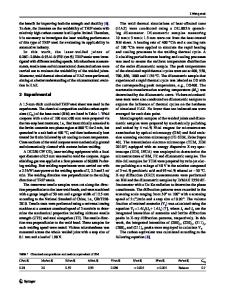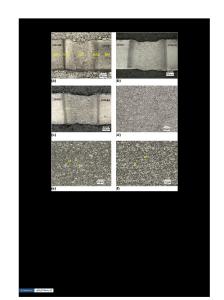Microstructure and Mechanical Properties of Laser Welded Titanium 6Al-4V
- PDF / 2,185,632 Bytes
- 7 Pages / 594 x 774 pts Page_size
- 58 Downloads / 377 Views
I.
INTRODUCTION
L A S E R welding is ordyjust beginning to be widely accepted as an industrial production process. Numerous experiments over the last decade have shown, however, that the laser is capable of producing precision weld joints of a high quality rivaled only by an electron beam. The scope for technically and commercially feasible laser welding applications has increased greatly since the development of multikilowatt continuous wave (CW) CO2 lasers around 1970, ~'2'3 capable of producing power densities greater than 106 W//cm 2 at which deep penetration welding is possible. The mechanism of penetration welding by a laser is similar to that encountered with an electron beam, i.e., energy transfer via keyhole. 4'~'6 This keyhole may be produced when a beam of such high power density causes vaporization of the workpiece surface, creating a hole. The hole acts as a radiation trap, or blackbody, enhancing the coupling of the beam energy into the workpiece. Vapor is ejected from the hole at or near sonic speeds dragging with it molten material and stabilizing the molten walls of the keyhole. A high depth-to-width fusion zone results. Currently the electron beam welding (EBW) technique is the most popular method for welding Ti-6A1-4V, an alloy which is widely used in the aerospace industries for its remarkable strength/weight ratio and resistance to high temperature creep. However, deep penetration of EBW extends only a short distance in a nonvacuum environment, and so for optimum efficiency electron beam welding needs to be clone in a vacuum. 4 Recent work on EBW outside a vacuum has made advances toward better penetration, but the process still suffers from producing much wider weld zones more akin to a plasma arc and generates X-rays. The latter is the result of the inescapable physics of the process. By contrast, laser beams can be transmitted for appreciable distances through the atmosphere without serious attenuation or optical degradation, and a simple energy balance shows that the photon energy in the laser beam will never be able to cause the ejection of more powerful photons such as X-rays. J. MAZUMDER is Assistant Professor, Department of Mechanical and Industrial Engineering, University of Illinois at Urbana-Champaign, Urbana, IL 61801. W. M. STEEN is Lecturer, Department of Metallurgy and Materials Science, Imperial College, London, United Kingdom. Manuscript submitted July 7, 1980. METALLURGICAL TRANSACTIONS A
The laser thus offers an easily maneuvered, chemically clean, high intensity, atmospheric welding process capable of producing deep penetration welds (aspect ratio greater than 1:1) with a narrow heat affected zone (HAZ) and subsequent low distortion. The application of laser welding to a difficult metal such as a titanium alloy which is subject to rapid oxygen pick-up and fast grain growth is not only of interest to the aerospace and chemical industries but also as a study into the welding of a chemically sensitive metal with a complex temperature dependent structure. Although there are a
Data Loading...











